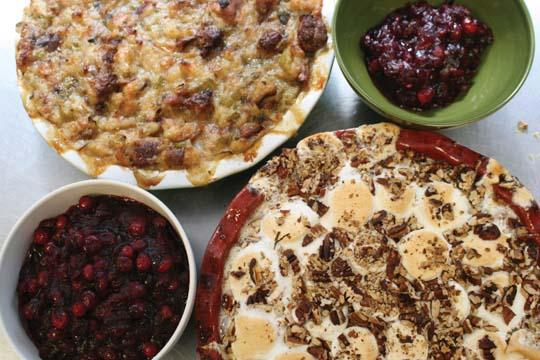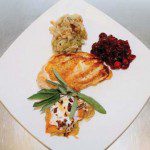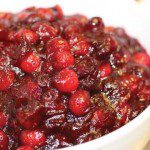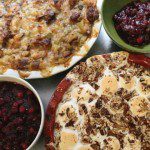Across the Cutting Board with Ris: Thanksgiving Special
By • November 17, 2010 0 1726

.
.
.
.
.
.
.
.
.
.
.
.
.
.
To Ris Lacoste, Thanksgiving should be a simple affair. The dishes featured on her restaurant’s “To Go Sides and Pies” menu are effusive and original, yet comforting and familiar. The cuisine goes beyond unique spins on old favorites, recalling brilliant tastes or textures and producing them in an entirely new context. But Thanksgiving isn’t about reinventing the wheel, as she makes clear. To her, Thanksgiving is the raw, savory, unfettered beauty of the fall harvest and family. “I dedicate Thanksgiving dinner to my mother,” she says. “I still can’t do it like she can.”
Preparing Thanksgiving dinner in a cramped kitchen with an undersized oven and limited counter space, Ris’ mother had a graceful choreography and skill. Wielding casseroles, turkeys, stuffing, gravy, and everything in between, she singularly churned out unforgettable, steaming hot Thanksgiving dinners year after year for her large family. The love in Ris’ voice, as she recalls these moments, illuminates the role her mother surely played in her initial passion for cooking.
What makes this holiday Ris’ “absolutely favorite all time meal,” is the patience and warmth it instills within us all: a long preparation, the slow gathering of guests, the cooling effect of the fall weather and the brightness and energy it brings with it, and the football game whirring in the background. It is perhaps the only holiday not crowded by commercialism she says. It’s the calmest American holiday, where you’re free to sit back and “enjoy the tryptophan buzz.”
Now, this isn’t to say that it’s a cakewalk in the kitchen. While the food should be simple, rich, and balanced, a Thanksgiving dinner is a tremendous undertaking. When she ran 1789 Restaurant, Ris began Thanksgiving preparations ten days out for 700 guests, and through her years of experience, she punches one point above all others: Have your MISE EN PLACE. For those who don’t know, this effectively means to keep organized, be ahead of the game, and THINK. Dice all your vegetables, measure all your ingredients, get out your cooking tools, sharpen your knives, and have everything laid out before you begin cooking. “Everything you can do ahead of time,” says Ris, “do it.”
She advises to start prepping a week in advance. Get your turkey, which will probably need to thaw. “Thaw it outside on your back porch if you have to,” she suggests. The nighttime weather is perfect this time of year for thawing a bird. Get all your non-perishables: potatoes, cranberries, marshmallows, onions, and squash.
Think and plan ahead. Turkey, for example, takes a lot of oven time. So what to do about all those other dishes that need to be baked or broiled? If they are dishes that can be warmed up, like casserole or stuffing, make them a couple of days before and reheat them on Thanksgiving Day. “Work it out so all you have to do on Thanksgiving Day is cook the turkey, make the gravy, mash the potatoes, and cook the green vegetables,” she says.
Ris and I decided to focus on anything but the bird. Debates will always rage on the best method to cook a turkey. Some brine it. Others insist upon smoking it. Some stick a Budweiser in its back end and deep-fry it in an oil drum. All of these methods can be rather delicious, and all require different techniques and equipment.
But birds aside, a Thanksgiving meal should strive to find a perfect balance: the savory and the tart, the bitter and the sweet, the rich and the light. The brightness of Thanksgiving dinner is the interplay of its components, the harmony and orchestration of flavors, says Ris, “as if all the dishes grew up together and played in the sandbox and complemented each other, bringing out each other’s best.”
In our case, the dishes were bread stuffing with sausage and sage, sweet potato gratin, and cranberry sauce with vanilla, maple syrup, and cassis.
Stuffing, she tells me, can be loaded with any bread you want: crusty white, rye, pumpernickel, wheat, whatever. Cornbread, she says, is especially good. Oysters, Cajun spices, grains, and nuts all make nice additions. The possibilities are endless. Hers is fairly traditional, but as this recipe proves, a little goes a long way. A bit of cayenne brightens up the juices from the sausage, and the sage and thyme compliment the cranberry sauce brilliantly.
You’ll be eating the cranberry sauce straight with a spoon. The orange cuts the tartness, and the maple and cassis add a wonderful depth to what is usually a very plain sweetness. She showed me that the cranberry sauce doesn’t require much liquid. Cranberries are filled with a great deal of pectin, a natural gelatin that acts as a gelling agent, such as in jams and jellies. When cooking the cranberries, they begin to pop, and the pectin gets to work.
A refreshing spin on sweet potato casserole, the gratin would be a welcome addition to any Thanksgiving table. I watched her slice the sweet potatoes very thin, not much thicker than a water cracker. Thicker potatoes will slide around, she explains. They won’t stand up when plated, and the presentation will be sloppy. Thinner slices will bind better, as more of the starches will release and act as glue. “Like the mortar in between the bricks,” she said.
Thanksgiving, says Ris, is a true fall harvest, highlighting the season’s choice offerings: root vegetables, potatoes, cabbage, pumpkin, greens, herbs, and grains. As a cook, you should enrich the traditions by using as many fresh and locally grown ingredients as you can get your hands on. While some of the smaller farmers’ markets may have begun to close, Dupont Circle and Arlington’s markets are open year-round, and Whole Foods is always a good place to check for organic, local produce. Freshfarmmarkets.org is a helpful site if you’re looking for places to find local produce or fresh markets.
If you can’t find the time to prepare a complete Thanksgiving meal, these dishes and more will be available right from Ris’ kitchen for your table, including pies, sides, gravy, and cranberry orange bread. Call the restaurant as soon as possible to place your order or go to www.RisDC.com.
Cranberry Sauce with Vanilla, Maple Syrup & Cassis
(Yields about 4 cups)
6 cups (about 1 1/2 lbs.) fresh or frozen cranberries, picked over and rinsed
2/3 cup granulated sugar
1/3 cup fresh orange juice (from 1 orange)
1/3 cup crème de cassis black-currant liqueur)
1/4 cup maple syrup
1 Tbs. finely grated orange zest (from 1 orange)
Half a vanilla bean, split and scraped
1 cinnamon stick
Put 3 cups of the cranberries and all the remaining ingredients in a 4-qt. saucepan. Bring to a boil over medium-high heat, reduce the heat to medium, and cook, stirring occasionally, until the cranberries have popped and broken down and the juices look slightly syrupy, 5 to 7 minutes. Stir in the remaining 3 cups cranberries and cook until these have popped, 3 to 5 minutes more. Remove from the heat, discard the vanilla bean and cinnamon stick, and let cool to room temperature. Cover and refrigerate if not serving right away.
Ris Tips:
The cranberry sauce can be made up to one week in advance if refrigerated.
Return to room temperature before serving.
Sweet Potato Gratin with Caramelized Onions
(Serves twelve)
2 oz. (4 Tbs.) unsalted butter; more for the baking dish
2 lbs. yellow onions, thinly sliced (about 6 cups)
1/4 cup sherry
1/2 tsp. kosher salt; more to taste
1/2 tsp. freshly ground black pepper; more to taste
2 cups heavy cream
3 sprigs fresh thyme
1/2 Tbs. freshly grated orange zest (from 1 orange)
1/2 tsp. cayenne
4 lbs. sweet potatoes (about 5 medium)
1/2 cup freshly grated Parmiagiano-Reggiano
1 bag of marshmallows
1 cup (4 oz.) pecan halves, toasted and chopped
Heat the butter in a heavy-based 12-inch skillet over medium heat until it begins to foam. Add the onions, reduce the heat to medium low, and cook slowly, stirring occasionally, until the onions are soft and nicely browned, about 30 minutes. Deglaze with the sherry and let cook until liquid has evaporated, about 3 minutes. Season with the 1/2 tsp. each salt and pepper. Remove from the heat and set aside to cool slightly.
Meanwhile, put the heavy cream, thyme, orange zest, and cayenne in a 2- to 3-qt. saucepan. Bring to a boil, remove from the heat, and steep for 15 minutes. Remove and discard the thyme sprigs.
While the cream is steeping, peel and cut the sweet potatoes crosswise into 1/8-inch-thick slices.
Position a rack in the center of the oven and another rack directly below. Heat the oven to 350°F.
Lightly butter a 9 x 13-inch baking dish. Arrange about one-third of the sliced sweet potatoes in a double layer on the bottom of the dish, slightly overlapping the slices in each layer. Season lightly with salt and pepper. Spread half of the onions over the potatoes and drizzle about one-third of the cream (2/3 cup) over the onions. Sprinkle one-third of the grated parmesan cheese. Arrange another third of the potatoes in two more overlapping layers and season lightly with more salt and pepper Spread the remaining onions over the potatoes and drizzle another third of the cream over the onions. Sprinkle another third of the grated parmesan. Use the remaining sweet potato slices to make two final layers, pressing down with your hands to compact them. Season lightly with salt and pepper, and drizzle the remaining cream over the potatoes, trying to cover them as much as possible. Sprinkle with the remaining grated parmesan.
Put a foil-lined baking sheet on the lower rack to catch any drips. Cover the gratin tightly with foil and bake on the center rack until the potatoes are almost tender but still offer a little resistance when pierced with a fork, about 1 hour. Remove the foil and bake until the sweet potatoes are completely tender and the top is lightly browned and bubbly, 30 to 40 minutes.
Raise the oven temperature to 375°F. Cover the top of the gratin with a single tight layer of marshmallows and sprinkle with all of the chopped pecans. Return the baking dish to the oven and bake until the marshmallows are beautifully toasted to a golden brown, about 5 minutes or less. Keep an eye out not to burn them.
Ris Tips:
The onions can be made up to 3 days in advance, if refrigerated in a bowl covered with plastic.
The gratin can be baked up to 1 day ahead to the point of adding the marshmallow topping; reheat at 375°F until bubbling hot throughout, about 20 minutes, add the topping, then bake 5 minutes or less.
Heating the cream beforehand will speed up the gratin’s cooking time.
Sausage-Maple Bread Stuffing
(Serves twelve)
2 lbs. dense, chewy bread, cut into 3/4-inch cubes (about 15 cups)
3 oz. (6 Tbs.) unsalted butter, softened
1/3 cup chopped fresh thyme leaves (from about 1 oz. thyme sprigs)
1/3 cup chopped fresh sage leaves (from about 3/4 oz. sage sprigs)
3/4 tsp. poultry seasoning
3 cups medium-diced yellow onion (2 medium)
3 cups medium-diced celery (6 large stalks)
7 1/2 cups low-salt chicken broth
2 bay leaves
1 smoked ham hock (about 1 lb.)
1 1/2 lbs. bulk pork breakfast sausage
1/3 cup maple syrup
1 1/2 tsp. freshly ground black pepper
Kosher salt
Lay the bread cubes in a single layer on two baking sheets. Leave out to dry completely at room temperature, tossing once or twice, for about two days.
Position a rack in the center of the oven and heat the oven to 375°F.
In a heavy-based, 8-qt. stockpot or Dutch oven, melt 3 Tbs. of the butter over medium heat until it begins to foam. Adjust with more liquid or bread depending on desired texture. Stir in the thyme, sage, and poultry seasoning and cook just enough to coat the herbs and season the butter, 30 to 60 seconds. Stir in the onions and celery and cook, stirring occasionally, until soft and fragrant, about 15 minutes. Add the chicken broth, bay leaves, and ham hock and bring to a boil over high heat. Reduce the heat to medium low and simmer until the liquid reduces by one-third, about 30 minutes.
Meanwhile, put the sausage on a rimmed baking sheet and break it into quarter-size chunks. Roast until cooked through, about 15 minutes. Let cool, and then chop the sausage into smaller bits.
Add the sausage to the broth and simmer just to allow the flavors to meld, about 5 minutes. Remove the ham hock and bay leaves. Discard the bay leaves and set the hock aside to cool. Stir the dried bread, several cups at a time, into the broth until all of the broth is absorbed and the bread cubes are well moistened. Stir in the maple syrup, pepper, and the remaining 3 Tbs. butter.
When the hock is cool enough to handle, pick off the meat, chop it into small pieces, and add to the stuffing. Season to taste with salt if necessary (depending on the sausage and ham hock, both of which are salty, there may already be enough).
Transfer the stuffing to a 9×13-inch baking dish and bake uncovered at 375°F until heated through and crisp on top, about 20 minutes if freshly made, or about 30 minutes if made ahead.
Ris Tips:
The bread can be dried weeks in advance, bagged, frozen, and then thawed when ready to use.
The stuffing can be made (but not baked) up to 2 days ahead and refrigerated, covered.
- Cranberry sauce with vanilla, maple syrup and Cassis; sweet potato Gratin (below); sausage-maple bread stuffing (above) | Erin Houston




